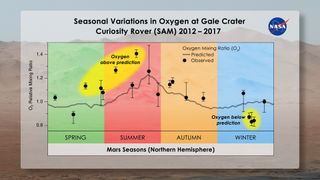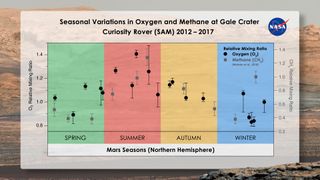Another possible biosignature gas is behaving strangely in Mars' air.
We already knew, thanks to NASA's Curiosity Mars rover, that methane levels in the 96-mile-wide (154 kilometers) Gale Crater rise significantly during the summer months and that concentrations of the gas have spiked dramatically several times over the past few years, for unknown reasons. And now, a new study reports that the six-wheeled robot has observed something similar with oxygen, another potential sign of life.
"We're beginning to see this tantalizing correlation between methane and oxygen for a good part of the Mars year," study co-author Sushil Atreya, a professor of climate and space sciences at the University of Michigan in Ann Arbor, said in a statement. "I think there's something to it. I just don't have the answers yet. Nobody does."
Related: Amazing Mars Photos by NASA's Curiosity Rover (Latest Images)

Graph showing oxygen levels inside Mars' Gale Crater, as measured by NASA's Curiosity Mars rover.
(Image credit: Melissa Trainer/Dan Gallagher/NASA Goddard)
The newly reported results come courtesy of Curiosity's Sample Analysis at Mars (SAM) instrument, a small chemistry lab that the rover carries on its body. The mission team has been using SAM to characterize the Red Planet's atmosphere and analyze samples of dirt and drilled rock since Curiosity landed inside Gale Crater in August 2012.
The new study, which was published online Tuesday (Nov. 12) in the Journal of Geophysical Research: Planets, provides a detailed look at the SAM atmospheric measurements from 2012 to 2017. The data show that the air inside Gale Crater is 95% carbon dioxide (CO2) by volume, 2.6% molecular nitrogen (N2), 1.9% argon (Ar), 0.16% molecular oxygen (O2) and 0.06% carbon monoxide (CO).
There are no surprises in those numbers. But the team found that O2 levels don't follow the same seasonal patterns as those other gases, rising considerably higher than predicted in the spring and summer and falling below expected levels during the Gale Crater winter.
And that was definitely a surprise.
"The first time we saw that, it was just mind-boggling," Atreya said.
The researchers checked and rechecked SAM's accuracy, determining that the instrument is working just fine. And they investigated multiple possible explanations but didn't find one that bears up under scrutiny. For example, the summer O2 boost could theoretically result from the splitting of CO2 or water molecules in Mars' atmosphere. But it would take five times more water in the air than has been observed to make that happen, study team members said, and CO2 doesn't break apart with the requisite speed.
So the O2 variation, like the methane fluctuations, remains mysterious for now.
"We're struggling to explain this," study leader Melissa Trainer, a planetary scientist at NASA's Goddard Space Flight Center in Greenbelt, Maryland, said in the same statement. "The fact that the oxygen behavior isn't perfectly repeatable every season makes us think that it's not an issue that has to do with atmospheric dynamics. It has to be some chemical source and sink that we can't yet account for."

The behavior of oxygen in Gale Crater tracks closely with that of methane, NASA's Curiosity Mars rover mission has found.
(Image credit: Melissa Trainer/Dan Gallagher/NASA Goddard)
But the mystery does not justify jumping to the conclusion that Mars microbes are involved, the scientists stressed. Indeed, some kind of geological process is likely responsible, study team members said. (Both methane and oxygen can be produced by abiotic and biological processes.)
Curiosity is not equipped to determine whether oxygen or methane was produced by living creatures. But more data could shed additional light on this Mars mystery, and SAM will keep sniffing the Red Planet air.
"For me, this is an open call to all the smart people out there who are interested in this: See what you can come up with," Trainer said.
Mike Wall's book about the search for alien life, "Out There" (Grand Central Publishing, 2018; illustrated by Karl Tate), is out now. Follow him on Twitter @michaeldwall. Follow us on Twitter @Spacedotcom or Facebook.

Need more space? Subscribe to our sister title "All About Space" Magazine for the latest amazing news from the final frontier!
(Image credit: All About Space)
https://www.space.com/mars-oxygen-mystery-curiosity-rover.html
2019-11-13 11:49:00Z
52780434167813
Tidak ada komentar:
Posting Komentar